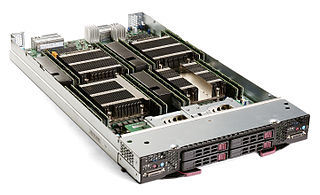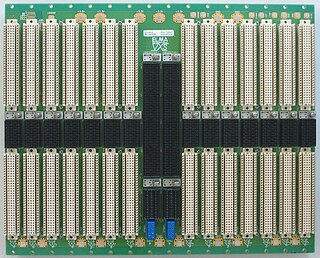Related Research Articles

Eurocard is a European standard format for printed circuit board (PCB) cards that can be plugged together into a standard chassis which, in turn, can be mounted in a 19-inch rack. The chassis consists of a series of slotted card guides on the top and bottom, into which the cards are slid so they stand on end, like books on a shelf. At the spine of each card is one or more connectors which plug into mating connectors on a backplane that closes the rear of the chassis.

VMEbus is a computer bus standard, originally developed for the Motorola 68000 line of CPUs, but later widely used for many applications and standardized by the IEC as ANSI/IEEE 1014-1987. It is physically based on Eurocard sizes, mechanicals and connectors, but uses its own signalling system, which Eurocard does not define. It was first developed in 1981 and continues to see widespread use today.

A single-board computer (SBC) is a complete computer built on a single circuit board, with microprocessor(s), memory, input/output (I/O) and other features required of a functional computer. Single-board computers are commonly made as demonstration or development systems, for educational systems, or for use as embedded computer controllers. Many types of home computers or portable computers integrate all their functions onto a single printed circuit board.

Electronic test equipment is used to create signals and capture responses from electronic devices under test (DUTs). In this way, the proper operation of the DUT can be proven or faults in the device can be traced. Use of electronic test equipment is essential to any serious work on electronics systems.

CompactPCI is a computer bus interconnect for industrial computers, combining a Eurocard-type connector and PCI signaling and protocols. Boards are standardized to 3U or 6U sizes, and are typically interconnected via a passive backplane. The connector pin assignments are standardized by the PICMG US and PICMG Europe organizations. The connectors and the electrical rules allow for eight boards in a PCI segment. Multiple bus segments are allowed with bridges.

A blade server is a stripped-down server computer with a modular design optimized to minimize the use of physical space and energy. Blade servers have many components removed to save space, minimize power consumption and other considerations, while still having all the functional components to be considered a computer. Unlike a rack-mount server, a blade server fits inside a blade enclosure, which can hold multiple blade servers, providing services such as power, cooling, networking, various interconnects and management. Together, blades and the blade enclosure form a blade system, which may itself be rack-mounted. Different blade providers have differing principles regarding what to include in the blade itself, and in the blade system as a whole.

PICMG, or PCI Industrial Computer Manufacturers Group, is a consortium of over 140 companies. Founded in 1994, the group was originally formed to adapt PCI technology for use in high-performance telecommunications, military, and industrial computing applications, but its work has grown to include newer technologies. PICMG is distinct from the similarly named and adjacently-focused PCI Special Interest Group (PCI-SIG).
Communications servers are open, standards-based computing systems that operate as a carrier-grade common platform for a wide range of communications applications and allow equipment providers to add value at many levels of the system architecture.

COM Express, a computer-on-module (COM) form factor, is a highly integrated and compact computer that can be used in a design application much like an integrated circuit component. Each module integrates core CPU and memory functionality, the common I/O of a PC/AT, USB, audio, graphics (PEG), and Ethernet. All I/O signals are mapped to two high density, low profile connectors on the bottom side of the module. COM Express employs a mezzanine-based approach. The COM modules plug into a baseboard that is typically customized to the application. Over time, the COM Express mezzanine modules can be upgraded to newer, backwards-compatible versions. COM Express is commonly used in Industrial, military, aerospace, gaming, medical, transportation, Internet of things, and general computing embedded applications.

A system on a module (SoM) is a board-level circuit that integrates a system function in a single module. It may integrate digital and analog functions on a single board. A typical application is in the area of embedded systems. Unlike a single-board computer, a SoM serves a special function like a system on a chip (SoC). The devices integrated in the SoM typically requires a high level of interconnection for reasons such as speed, timing, bus width etc.. There are benefits in building a SoM, as for SoC; one notable result is to reduce the cost of the base board or the main PCB. Two other major advantages of SoMs are design-reuse and that they can be integrated into many embedded computer applications.

VPX, also known as VITA 46, refers to a set of standards for connecting components of a computer, commonly used by defense contractors. Some are ANSI standards such as ANSI/VITA 46.0–2019. VPX provides VMEbus-based systems with support for switched fabrics over a new high speed connector. Defined by the VMEbus International Trade Association (VITA) working group starting in 2003, it was first demonstrated in 2004, and became an ANSI standard in 2007.
ESMexpress is a very compact computer-on-module (COM) standard. It is a complete processor module that currently supports several low-power Intel and PowerPC platforms. Apart from a CPU component, every module also includes memory and a range of serial communication interfaces such as PCI Express, Gigabit Ethernet, USB, SATA, SDVO, LVDS and HD audio. These interfaces are defined in the form factor's specification, and signals are assigned to two 120-pin connectors. This fixed pin mapping ensures that different ESMexpress modules can be exchanged more easily. Consequently, ESMexpress typically does not have an onboard FPGA. The idea behind this is to implement very specialized functions in an FPGA on the COM's carrier board to ease upgrades of the system CPU through exchange of the ESMexpress module.

ADLINK Technology Inc. is a company that designs and manufactures products for embedded computing, test and measurement, and automation applications. ADLINK's product line includes computer-on-modules, industrial motherboards, data acquisition modules and complete systems. Headquartered in Taiwan, ADLINK has operations in Beijing, Mannheim, Paris, San Jose, Seoul, Shanghai, Shenzhen, Singapore and Tokyo. ADLINK sells to original equipment manufacturers (OEMs) and system integrators.
CompactPCI PlusIO is an extension to the PICMG 2.0 CompactPCI industrial standard for modular computer systems. CompactPCI PlusIO was officially adopted by the PCI Industrial Computer Manufacturers Group PICMG as PICMG 2.30 CompactPCI PlusIO in November 2009. Being 100% compatible with CompactPCI, PICMG 2.30 defines a migration path to the future CompactPCI Serial standard. It defines a fixed rear I/O pin assignment that focuses on modern, fast serial point-to-point connections. The new technology succeeding parallel CompactPCI comprises both CompactPCI Serial and CompactPCI PlusIO.
CompactPCI Serial is an industrial standard for modular computer systems. It is based on the established PICMG 2.0 CompactPCI standard, which uses the parallel PCI bus for communication among a system's card components. In contrast to this, CompactPCI Serial uses only serial point-to-point connections. CompactPCI Serial was officially adopted by the PCI Industrial Computer Manufacturers Group PICMG as PICMG CPCI-S.0 CompactPCI Serial in March 2011. Its mechanical concept is based on the proven standards of IEEE 1101-1-1998 and IEEE 1101-10-1996. CompactPCI Serial includes different connectors that permit very high data rates. The new technology standard succeeding parallel CompactPCI comprises another specification called PICMG 2.30 CompactPCI PlusIO. This is why CompactPCI Serial and CompactPCI PlusIO as a whole were also called CompactPCI Plus. PICMG's first working title of CompactPCI Serial was CPLUS.0. CompactPCI Serial backplanes and chassis are developed by Schroff, Elmа, and Pixus Technologies companies, as for the CompactPCI Serial board level electronics – they are developed by MEN Mikro Elektronik, Fastwel, EKF, Emerson Embedded Computing, ADLINK, Data Patterns and Kontron.
Eurotech is a company dedicated to the research, development, production and marketing of miniature computers (NanoPCs) and high performance computers (HPCs).

Elma Electronic is a publicly traded Swiss electronics company founded in 1960 and based in Wetzikon, Switzerland. The company has 5 product divisions: Systems Platforms, Backplanes, Enclosures & Components, Rotary Switches, and Cabinet Enclosures. The largest segment is systems packaging serving the military, aerospace, homeland security, medical and industrial markets. The Elma Bustronic division develops backplanes, including VME320, which was the world's fastest VME backplane in 1997. Elma Bustronic also develops backplanes in OpenVPX, VMEbus, VME64X, CompactPCI, MicroTCA, and custom bus structures. Elma is an executive member of the PCI Industrial Computer Manufacturers Group (PICMG), VME International Trade Association, and member of the OpenVPX Industry Working Standards Group.

Integrated Device Technology, Inc., is an American corporation headquartered in San Jose, California, that designs, manufactures, and markets low-power, high-performance mixed-signal semiconductor solutions for the advanced communications, computing, and consumer industries. The company markets its products primarily to original equipment manufacturers (OEMs). Founded in 1980, the company began as a provider of complementary metal-oxide semiconductors (CMOS) for the communications business segment and computing business segments. The company is focused on three major areas: communications infrastructure, high-performance computing, and advanced power management.
Acromag, Inc. manufactures embedded computing, process instrumentation, and distributed I/O products.
Spectrum Signal Processing by Vecima is a technology company and commercial off-the-shelf (COTS) product provider, based in Vancouver, British Columbia. Spectrum designs and builds board and system-level hardware and software solutions for signal processing applications. Since May 2, 2007, Spectrum has operated as a division of Vecima Networks Inc., a Canadian technology company. In addition, Spectrum Signal Processing (USA), Inc. is a subsidiary of Vecima Networks Inc., and is primarily a sales organization for Spectrum's products in the United States.
References
- ↑ "Charles Michael Hayward Obituary". Chapman Funerals and Cremation. March 31, 2021. Retrieved November 8, 2021.
- ↑ "Boards Customized for Wire Wrapping". Computer World. February 12, 1979. p. 101. Retrieved November 8, 2021.
- ↑ Mathew French (September 4, 2000). "Personnel File". Boston Business Journal. Retrieved November 8, 2021.
- ↑ "Membership". PICMG Web site. Archived from the original on May 11, 2008. Retrieved November 8, 2021.
- ↑ "Membership Roster". VITA Web site. Archived from the original on September 29, 2010. Retrieved November 8, 2021.
- ↑ "VITA Members Form VPX Marketing Alliance". December 10, 2009. Archived from the original on September 7, 2010. Retrieved November 8, 2021.
- ↑ Kathleen Hickey (October 20, 2009). "Live OpenVPX system unveiled at Milcom". Defense Systems. Retrieved November 8, 2021.
- ↑ Tish Drake (June 3, 2010). "Curtiss-Wright Acquires Hybricon Corp". Aviation Today. Retrieved November 8, 2021.
- ↑ Chris Cuifo (August 13, 2010). "Acquisitions expand the two defense companies' value as they use more COTS hardware". Military Embedded Systems. Retrieved November 8, 2021.
- ↑ Chris Cuifo (December 14, 2010). "Too cool: New patent-pending CoolWall chassis sandwiches alloys and takes the heat beyond the competition". Military Embedded Systems. Retrieved November 8, 2021.
- ↑ "About Us". Atrenne web site. Retrieved November 8, 2021.
- ↑ "Atrenne Integrated Solutions Acquires Hybricon". Press release. July 2, 2015. Retrieved November 8, 2021.
- ↑ "AbelConn Electronics, CBT Technology, Photo Etch, and SIE Computing Solutions announce merger to create Atrenne Integrated Solutions". Press release. October 30, 2014. Retrieved November 8, 2021.
- ↑ "Celestica Completes Acquisition of Atrenne Integrated Solutions". Press release. April 4, 2018. Retrieved November 8, 2021.